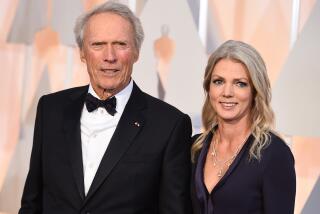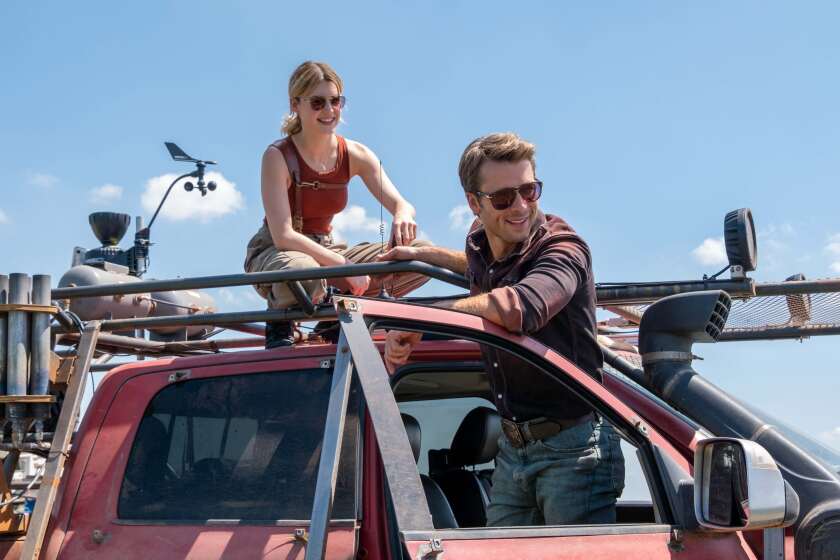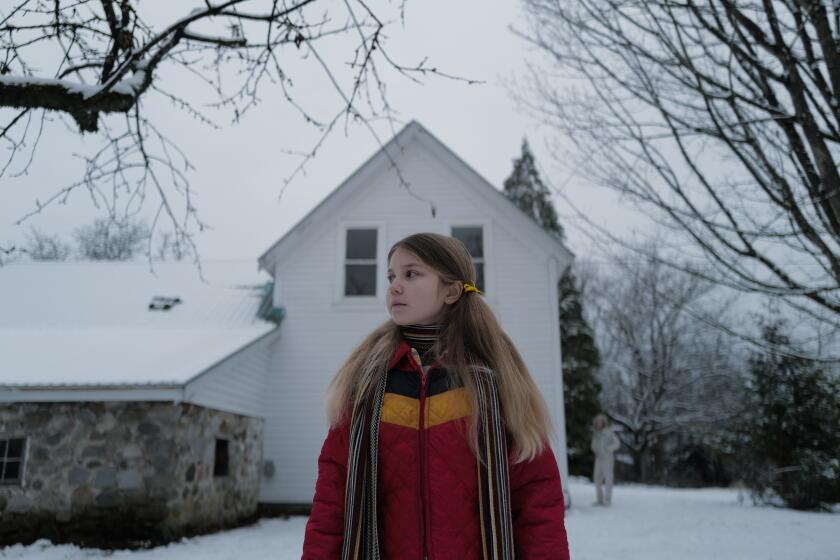A Chronicle of Catastrophe : THE DEVIL’S CANDY: The Bonfire of the Vanities Goes to Hollywood, <i> By Julie Salamon (Houghton Mifflin: $24.95; 384 pp.)</i>
What makes a big-time movie go bad? The script? Casting? Direction? All of the above?
Dicey questions. And few movie critics or reporters have ever been able to answer them as completely as Julie Salamon in “The Devil’s Candy.”
If this book isn’t quite the coup or classic some critics claim, it’s still a fine, cool-headed, fact-filled expose. More than anything, it’s the subject--and Salamon’s unusual access to it--that make “Candy” special. This many-sided account of the making (unmaking?) of the Warner Brothers version of Tom Wolfe’s novel “The Bonfire of the Vanities” takes us straight from the project’s inception through post-mortem--through planning, casting, costuming, location work, sound-stage shooting, editing and the more arcane labors of the loopers, mixers and Foley Artists--right on through to the film’s disastrous opening.
It’s a chronicle of catastrophe. Much like the novel’s protagonist Sherman McCoy, “Vanities,” the movie, began with seemingly every advantage--high position, beauty, celebrity, $40-50 million behind it. And, like McCoy, it came crashing down, under a fusillade of location-shooting woes, scathing “buzz,” scornful reviews, audience indifference and a final culminating recognition (by an American Film poll of the nation’s critics) as “the worst movie of 1990.”
How the mighty are fallen! Such is the theme of Wolfe’s novel. It shows how McCoy, a millionaire Wall Street investment bond salesman, finds his life in ruins after accidentally running down a black teen-ager on a Bronx off-ramp, while in the midst of an adulterous liaison; thereby turning prey for what seems a city-full of rabble-rousers and opportunists. And such is the theme of Salamon’s reportage--which she frames as a kind of gossipy cautionary tale. Invited by director Brian De Palma to observe the entire production, Salamon weaves--in a methodical, understated style that usually stresses fact over feeling--a tapestry of grand designs and grand folly, of hubris , blunders, inflation, self-delusion, miscasting, soaring budgets and a final awesome belly-flop.
The title, “The Devil’s Candy,” comes from original producer Peter Guber: It’s an arch come-on, describing Maria Ruskin, the Park Avenue temptress played in the movie by Melanie Griffith. For Salamon, obviously, the satanic sweets include all those temptations--of money, prestige, power and sex--connected with the making of a Big Movie. And if, as a writer, Salamon doesn’t suck the devil’s candy, or spit it out, she does keep teasing open the wrapper.
The book becomes a careful, dry look at excess and voluptuous overconsumption; it has a “Just the facts, Ma’am” crispness and financial savvy you might expect from a writer for the Wall Street Journal. The fun of “Candy” lies in its omniscient strategy: an all-seeing view that stems from De Palma’s unusual openness and is plainly inspired by “Picture,” Lillian Ross’ urbane and witty 1952 vivisection of John Huston’s film of “The Red Badge of Courage.” Its failure lies in the fact that it’s not quite omniscient enough . Salamon examines almost every aspect of the film-making process except the two that are the most crucial of all: the writing of the screenplay and the primary directorial strategies.
This thematic void may be part of the shoot’s atmosphere. The people involved with “Bonfire,” from executives to go-fers, almost never talk about its depths or meaning. Tough, wisecracking pros, they discuss instead its cost, look, salability, co-worker problems. On the set, almost all of them are involved in their own hustles: the small fry trying to rise, the larger fry angling for better jobs afterwards. Everyone assumes the same flip, brusque, can-do demeanor. Or they clam up: like the notably unquoted screenwriter Michael Christofer--and De Palma, whose long location affair with “Bonfire” actress Beth Broderick (the playgirl who sat on the photocopy machine in the film’s raunchiest scene) goes unmentioned until a sudden flurry at the end.
From Tom Wolfe onward, the “Bonfire” team seem to have made their deal with the devil--and, after they’ve tapped into that $50-million pile of candy, they’ve let the devil (and the millions) usurp all thought. Decision after decision puts the movie behind the eight ball. The wrong writer. The wrong actors. A location schedule in flux. Obstructionism by a publicity-hungry Bronx politico and a succession of censorious judges. Perhaps--though maybe not--the wrong director. The wrong audience research. The wrong ad campaign. One can almost hear Zero Mostel’s anguished cry from “The Producers”-- “Where did I go right?” --echoing over the mounting debacle: the absurd redemption that, here, will never come.
Anyone looking for culpability will find it lavishly spread around: the usual suspects, the ‘80s, and most of all, standard Hollywood practice. It was Guber who hired screenwriter Christofer, whose gentle, tentative and “humane” sensibility never jelled with Wolfe’s torrential wit and sarcasm--thereby killing most of the humor. Guber also insisted on casting youthful, likable Tom Hanks in the lead, having vetoed or ignored both William Hurt and the favorite candidate of both De Palma and Mike Nichols--Steve Martin. De Palma himself is responsible for the bizarre metamorphosis of Wolfe’s feisty Judge Mike Kovitsky, irascible Bronx Jewish jurist, into the stern, fatherly Afro-American “Judge White,” played by Morgan Freeman. Freeman’s last-minute casting--over Walter Matthau, Alan Arkin and the man on whom Kovitsky was actually modeled, Burton Roberts--created a series of location crises and upped the budget by, in Salamon’s estimate, $5 million.
The modern star system created the movie’s major casting gaffe. Bruce Willis expressed interest in the part of Peter Fallow, snobbish British journalist for a Post-like tabloid who breaks McCoy’s story, and was promptly snapped up, $5-million price tag and all, with the part completely overhauled--destroyed actually--to accommodate his smirking-stud persona.
Salamon has her faults: historical errors (Charles Foster Kane’s gubernatorial race is described as Kane-for-Congress), weird judgments (“Catch-22” is a “great film”), an alarming insistence on trumpeting the virtues and achievements of “Vanities’ ” second-unit director, Eric Schwab (he almost becomes the book’s Vicki Lester to De Palma’s foundering Norman Maine), an occasionally mundane style, and an apparent belief that “The Godfather 2” is the last part of Coppola’s trilogy.
But, overall, she’s a crackerjack reporter, one who never loses the core of the story. Conceived in the beginning as a definitive portrait of ‘80s greed, “Bonfire” quickly became a casualty of the ‘80s: of big money, of social and racial stereotypes, of the studio’s insistence on “insurance” (cuties Hanks and Griffith, superstar Willis) and of De Palma’s hapless attempts to redeem Wolfe’s implicit racism by dragging in Morgan Freeman and having him yell: “Decency! Please!”
That quagmire of compromise is “Candy’s” sticky center. “Final Cut,” Richard Bach’s book on “Heaven’s Gate,” suggested that movies could be undone by the willfulness of their talent; it was an implicit call for greater studio control. “The Devil’s Candy” takes the opposite tack. It suggests that the rigidity of the current studio system--its insistence on “elements,” marketability, big stars, simple stories and the tyranny of market research--dooms a project like “The Bonfire of the Vanities,” or any other offbeat effort. The studio’s basic philosophy is clearly that “difficult” (literate, thoughtful, iconoclastic, outrageous) pictures of any kind should be avoided. Since they would have preferred to make a Tom Hanks/ Melanie Griffith/Bruce Willis sex-comedy instead of “Bonfire of the Vanities,” that’s what they made--almost.
As it happens, “The Bonfire of the Vanities” was not 1990’s worst movie--or even close to it. It was just the most disappointing, mostly because of the book’s lost potential, and because that $50 million seems invisible on the screen. Despite some spectacular De Palma visuals, the film is so flat, airless and uninvolving, so unevocative of Manhattan and the Bronx, so filled with long set pieces and studio interiors, it looks like the medium-budget version of “The Bonfire of the Vanities.”
Yet, irony of ironies. . . . Wolfe’s book--despite its “problem areas,” its Tory elitism, “unlikable characters” and implict racism--is potentially wonderful movie material. But not for the vaguely nice-nasty expose that Christofer wrote or the “Dr. Strangelovian” satire De Palma envisioned; its truer models probably lie in the kaleidoscopic vein of “La Dolce Vita” or the best ‘30’s screwball comedies. Then it might have found its level: a hip, juicy, multileveled modern extravaganza (with, probably, a more sympathetic look at the black milieu that Wolfe travestied or ignored).
Instead, like the “Vanities” that Savonarola’s 15th-Century followers tossed on the Florentine bonfires, Wolfe’s satire, its promise, and the picture itself all wound up in the inferno of the marketplace. Salamon, at her best, puts this across. All the millions vanished. All the candy was eaten. The devil grabbed his dues. And after the hustles came down, the movie makers and public were left with a crock.
More to Read
Only good movies
Get the Indie Focus newsletter, Mark Olsen's weekly guide to the world of cinema.
You may occasionally receive promotional content from the Los Angeles Times.






